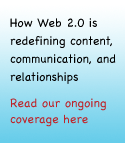Pervasive Consumer Connectivity Vision Upstaged by Enterprise Web 2.0 Collaboration
 Cisco’s John Chambers is a master technology marketer who quickens your pulse with technology fire and brimstone. However, as the long-time CEO of Cisco, which epitomized the rise of the (Silicon) Valley when it was briefly the most valuable company in the U.S. in 2000, he has seen the company through the tech bust and proven that he has substance and staying power. Although a hypemeister extraordinaire, he may have crystallized the promise of the Enterprise Web 2.0 better than any other speaker at Digital Hollywood Chicago.
Cisco’s John Chambers is a master technology marketer who quickens your pulse with technology fire and brimstone. However, as the long-time CEO of Cisco, which epitomized the rise of the (Silicon) Valley when it was briefly the most valuable company in the U.S. in 2000, he has seen the company through the tech bust and proven that he has substance and staying power. Although a hypemeister extraordinaire, he may have crystallized the promise of the Enterprise Web 2.0 better than any other speaker at Digital Hollywood Chicago.
Chambers’ demos of whiz-bang consumer entertainment scenarios were intriguing but far less interesting to an enterprise-focused audience than his accounts of how Cisco had drastically increased its already-leading efficiency in mergers and acquisitions by collaborating with Web 2.0 tools like wikis. We anticipate that his consumer-focused vision will be consummated far in the future, but his message about enterprise collaboration is achievable this year—for those who are looking for it.
Chambers described an emerging future of networks and communication that revolved around pervasive video, which will drive customer experience, collaboration and value. The world is entering a fundamentally new era in which communication is morphing from one-to-many to many-to-many. This will drive a new degree of collaboration and innovation, and it will change business models. Telecoms are not “coming back,” and there will be significant consolidation. Video will rise to prominence and will be created and experienced on any machine or device.
Network-Focused Vision and Business Models
 Web 2.0 is not new; it is like the Internet was in the 1990s. Telecom is old; the new focus must be Internet (digital) video, which will drive business process change. Video, voice, text, telepresence, blogging all drive more broadband; we have to redefine broadband; we must remove barriers. We estimate that this message is primarily to his clients, telecoms and global enterprises. The latest Cisco routers aim to intelligently deliver the right content to the right (user-operated) device, according to individual preferences, automatically.
Web 2.0 is not new; it is like the Internet was in the 1990s. Telecom is old; the new focus must be Internet (digital) video, which will drive business process change. Video, voice, text, telepresence, blogging all drive more broadband; we have to redefine broadband; we must remove barriers. We estimate that this message is primarily to his clients, telecoms and global enterprises. The latest Cisco routers aim to intelligently deliver the right content to the right (user-operated) device, according to individual preferences, automatically.- In the 1990s, we put orders online and outsourced manufacturing. We gave customers input into product development. In 2006, value and product development have slowed (we’ve pateaued). We have to take it to the next level.
- At Cisco, collaboration is producing incredible value, and we’re able to work must faster. For example, we acquired Scientific-Atlantic in 2005, and the transaction took 45 days to close. In February 2007, we closed the Webex acquisition in 8 days. We do most of the work on the Cisco wiki, and employees, partners and customers have appropriate access.
- Another proof point: Cisco’s innovation pipeline model (circa 2000) took thousands of innovation ideas and vetted the total down to about 250. We then eliminated all but three, and we acted on those. This year, through our Web 2.0 technology-enabled collaboration, we are doing 18 innovation projects. We have checked our command and control methods at the door. It increases scale and speed, and we feel that it will be sustainable. We are changing our business models to leverage these new capabilities.
- Cisco’s vision is that the network is becoming intelligent—from technology and human perspectives. Web 2.0 collaboration is making the Web intelligent. When you add unified communications (integrated video, text, audio, graphic), telepresence and open architectures, you realize that resources are available anytime, anywhere anyhow, and the network can infer your preferences based on where you are and what you’re doing and history.
 From a technology perspective, numerous “resources” that are contained by applications will leach into the network. Examples are security and quality of service.
From a technology perspective, numerous “resources” that are contained by applications will leach into the network. Examples are security and quality of service.- From an enterprise operations perspective, we can tap global services and virtual relationships worldwide (as new resources come on line in India, China and elsewhere).
- We can get it right by listening to customers. Virtualization is key on the business side; everything has to be online.
- Voice and video are the future, not text. (Interaction with devices) must be simple; people must get what they want in one click. Each subsequent required click loses customers.
- Proprietary technology and solutions are over. Everything must be open, must be architected like the human body: get anything anywhere, anytime you want.
- For example, we will change the experience within the stadium. HDTV offers the ability to see a game from any angle; currently you can choose from 30 angles (and they are not mutually exclusive). People will pay a premium for this.
 (demo with Hotel California) Listening in your car. You turn off your car and it resumes playing on your smartphone. Once you are in your house, the handheld hands off the song to your home stereo, but it fires up a music video. H-D pictures will drive additional demand.
(demo with Hotel California) Listening in your car. You turn off your car and it resumes playing on your smartphone. Once you are in your house, the handheld hands off the song to your home stereo, but it fires up a music video. H-D pictures will drive additional demand.- (demo with fantasy baseball) In fantasy baseball, you can pick plays (and presumably knit them together into a game; the plays are the building blocks to the game). You can purchase tickets on the device and receive the receipt, which you show to the ticket taker to gain admittance at the stadium.
- Three screens: content will be (created and) viewable on any device; we will have anytime calendars, and open architecture, which will provide additional revenue. Consumers will drive change. Everyone and everything will be connected.
- Telepresence (and video) will drive demand for our business. Video routers will be a huge growth area.
- Japan is experiencing 3-500% annual network growth.
- We will change the definition of broadband and set-top boxes (which are dumb catchers of data today; they will become far more interactive). People will pay for experience and guaranteed quality of service.
Analysis and Conclusions
- Chambers’ speech had a technology context, but the most important message was that Cisco was demonstrably accelerating innovation by adopting a collaborative model. Closing corporate transactions like acquisitions far more quickly is proof of an enterprise-scale reduction of transaction costs. That enables Cisco to undertake more transactions and to therefore be more responsive and adaptive. Growing their innovation pipeline six-fold is another huge advantage.
- Few people in the (communications) business would dispute the content of Chambers’ vision, but the big question is timing. It may take a couple of generations to be comfortable with being online and reachable from anywhere, anytime. It’s too Big Brotherish. But privacy is already shifting significantly, and this shift will continue. This uneven comfort level with the loss of privacy will serve to dampen adoption.
- Network operators (Cisco’s clients) like video because it is the most resource-intensive content we have and therefore drives utilization of network resources the most. Let’s not forget that Cisco is hawking video routers. Abstracting up a level, however, video is scalable, rich communication, and it is a closer facsimile of face-to-face communication than print. Humans’ first scalable communication was pictures, then writing. Of course, video incorporates audio and therefore stimulates vision and hearing. It does not yet incorporate touch, smell or taste.
- The network is becoming more intelligent, and this is a natural progression of the ongoing revolution in computing. Computers used to be islands of automation. Then they were connected, and connections served to make their computational power available to more people. Distributed computing and pervasive networks have diminished the relative importance of “computers” because software and hardware resources and services exist within the network, and abstracting out services makes sense in many situations.
- For most of humans’ existence, we have not had writing, and perhaps writing as a means of communication will diminish. However, for most cultures, writing is a key developmental activity that helps to develop analytical thinking. If it diminishes, how will its disappearance affect humankind’s analytical abilities?

Leave a Reply
You must be logged in to post a comment.